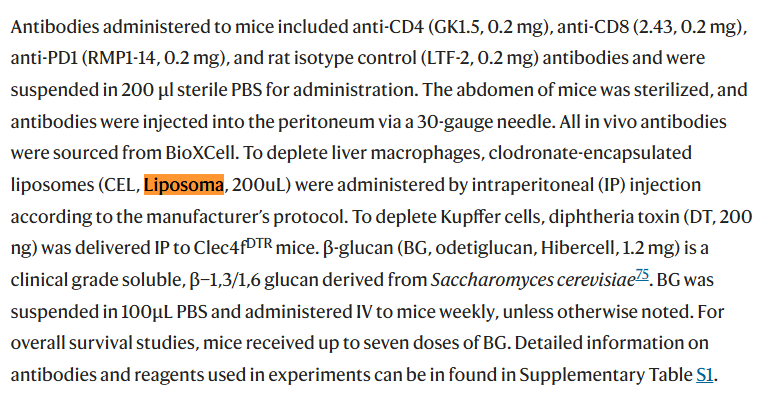中文摘要:
尽管巨噬细胞有助于癌细胞播散、免疫逃避和转移生长,但据报道它们也可以协调肿瘤特异性免疫反应。因此,我们假设可以通过治疗来调节巨噬细胞极化以防止转移。在这里,我们表明巨噬细胞通过抑制肝转移对β-葡聚糖(odetiglucan)治疗做出反应。β-葡聚糖激活肝脏驻留巨噬细胞(库普弗细胞),抑制癌细胞增殖,并在胰腺癌小鼠模型中调用针对肝转移的生产性 T 细胞介导的反应。尽管被排除在转移性病变之外,但库普弗细胞对于β葡聚糖的抗转移活性至关重要,而葡聚糖也需要 T 细胞。此外,β-葡聚糖驱动小鼠和人类肝转移瘤中的 T 细胞活化和巨噬细胞复极化,并使转移病灶对抗 PD1 治疗敏感。这些发现证明了巨噬细胞功能在转移中的重要性,并确定了库普弗细胞作为胰腺癌转移到肝脏的潜在治疗靶点。
英文摘要:
Although macrophages contribute to cancer cell dissemination, immune evasion, and metastatic outgrowth, they have also been reported to coordinate tumor-specific immune responses. We therefore hypothesized that macrophage polarization could be modulated therapeutically to prevent metastasis. Here, we show that macrophages respond to β-glucan (odetiglucan) treatment by inhibiting liver metastasis. β-glucan activated liver-resident macrophages (Kupffer cells), suppressed cancer cell proliferation, and invoked productive T cell-mediated responses against liver metastasis in pancreatic cancer mouse models. Although excluded from metastatic lesions, Kupffer cells were critical for the anti-metastatic activity of β-glucan, which also required T cells. Furthermore, β-glucan drove T cell activation and macrophage re-polarization in liver metastases in mice and humans and sensitized metastatic lesions to anti-PD1 therapy. These findings demonstrate the significance of macrophage function in metastasis and identify Kupffer cells as a potential therapeutic target against pancreatic cancer metastasis to the liver.
论文信息:
论文题目:Kupffer cells prevent pancreatic ductal adenocarcinoma metastasis to the liver in mice
期刊名称:Nature Communications
时间期卷:14, Article number: 6330 (2023)
在线时间:2023年10月10日
DOI:doi.org/10.1038/s41467-023-41771-z
产品信息:
货号:C-010
规格:10ml
品牌:Liposoma
产地:荷兰
名称:Clodronate Liposomes
办事处:Target Technology(靶点科技)
Clodronate Liposomes氯膦酸盐脂质体清除肝脏巨噬细胞,疾病模型为:门静脉注射PDACYFP-cells。PDAC是胰腺导管腺癌(Pancreatic Ductal Adenocarcinoma)的缩写,属于胰腺癌中常见且恶性程度高的类型,占胰腺恶性肿瘤的85%-90%。它起源于胰腺导管上皮细胞,侵袭性强、进展迅速,多数患者确诊时已处于中晚期,5年生存率不足10%。荷兰Liposoma巨噬细胞清除剂Clodronate Liposomes见刊于Nature Communications:Kupffer 细胞可防止小鼠胰腺导管腺癌转移到肝脏。

Liposoma巨噬细胞清除剂Clodronate Liposomes氯膦酸二钠脂质体的材料和方法:
Antibodies administered to mice included anti-CD4 (GK1.5, 0.2 mg), anti-CD8 (2.43, 0.2 mg), anti-PD1 (RMP1-14, 0.2 mg), and rat isotype control (LTF-2, 0.2 mg) antibodies and were suspended in 200 μl sterile PBS for administration. The abdomen of mice was sterilized, and antibodies were injected into the peritoneum via a 30-gauge needle. All in vivo antibodies were sourced from BioXCell. To deplete liver macrophages, clodronate-encapsulated liposomes (CEL, Liposoma, 200uL) were administered by intraperitoneal (IP) injection according to the manufacturer’s protocol. To deplete Kupffer cells, diphtheria toxin (DT, 200 ng) was delivered IP to Clec4fDTR mice. β-glucan (BG, odetiglucan, Hibercell, 1.2 mg) is a clinical grade soluble, β−1,3/1,6 glucan derived from Saccharomyces cerevisiae. BG was suspended in 100μL PBS and administered IV to mice weekly, unless otherwise noted. For overall survival studies, mice received up to seven doses of BG. Detailed information on antibodies and reagents used in experiments can be in found in Supplementary Table S1.

材料和方法文献截图:
